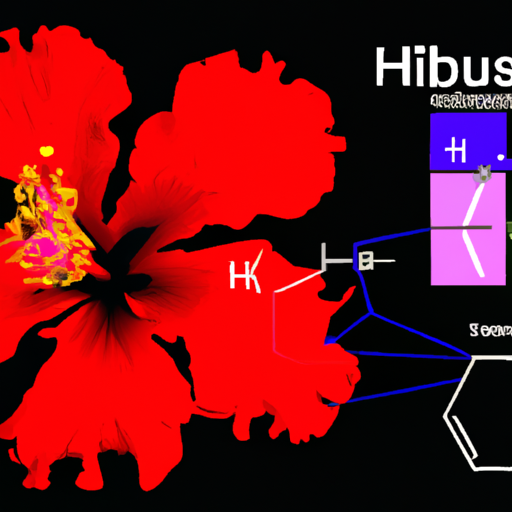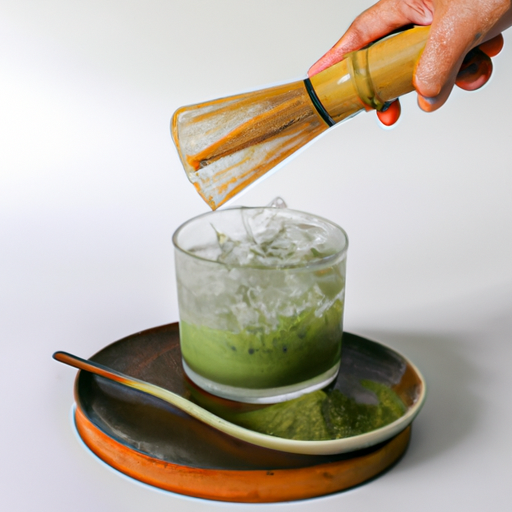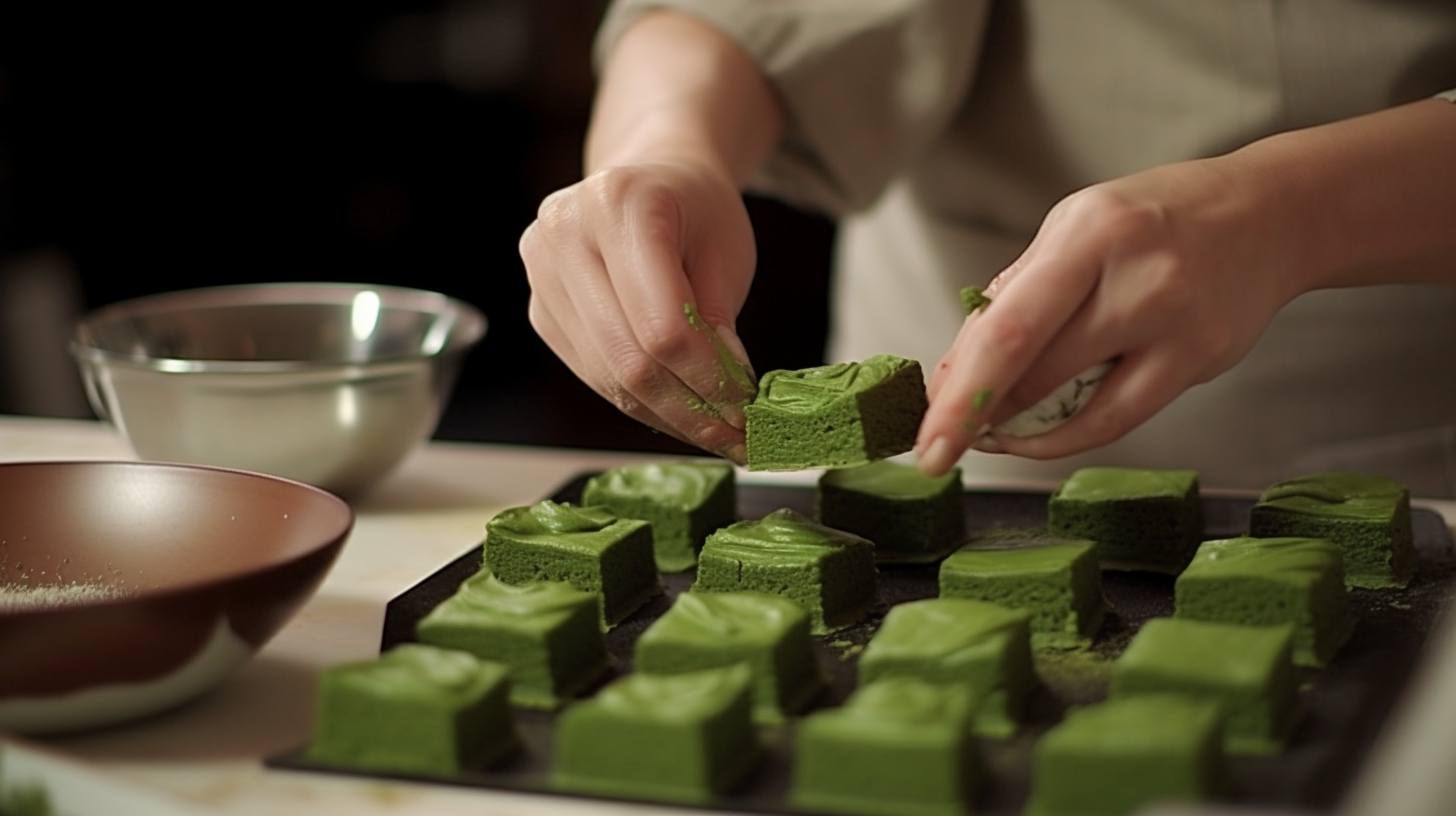I’ve enjoyed matcha for many years, and what I particularly appreciate about it is its versatility. No matter if I desire something sweet or savory, I can always find a method to add matcha to my dish.
But with so many different ingredients out there, it can be hard to know what pairs best with this delicious green tea powder. That’s why I’ve put together this guide on what to mix with matcha.
In this article, I’ll be sharing some classic pairings for matcha as well as some more creative options. We’ll explore fruits and berries, spices and herbs, nuts and seeds, sweeteners, dairy and non-dairy alternatives, baked goods, and even cocktails and mocktails.
Whether you’re a matcha newbie or a seasoned pro, there’s sure to be something here that you’ll want to try. So let’s get started!
Key Takeaways
- Matcha is a versatile ingredient that can be used in sweet and savory recipes, and offers a variety of health benefits.
- Classic pairings for matcha include milk and honey, lemon and ginger, and vanilla and almond milk. Fruits and berries like strawberries, blueberries, and pineapple also complement the earthy flavor of matcha.
- Adding nuts and seeds, different types of milk, and whipped cream or ice cream can elevate the flavor and texture of matcha creations.
- Matcha can be incorporated into baked goods, savory dishes, and cocktails and mocktails for a unique and delicious twist.
Classic Pairings
When it comes to classic pairings for matcha, there are a few that always come to mind for me.
First up is milk and honey, which adds a creamy sweetness to the earthy matcha flavor.
Another favorite is lemon and ginger, which gives the matcha a bright, zesty kick.
And for a more indulgent pairing, I love to mix matcha with vanilla and almond milk for a rich and nutty treat.
Milk and Honey
Mixing milk and honey with your matcha creates a deliciously creamy and sweet beverage. Not only does it taste great, but it also provides additional benefits to your matcha drink.
Here are three things to keep in mind when making your own milk and honey matcha:
-
Benefits of Milk and Honey in Matcha: Milk is a great source of protein and calcium, which can help keep you feeling full and satisfied. Honey, on the other hand, is a natural sweetener that can add a touch of sweetness without the use of refined sugar. Together, they create a delicious and nutritious addition to your matcha.
-
How to Choose the Best Milk for Matcha: When choosing a milk for your matcha, it’s important to consider the flavor and consistency. Whole milk will provide a creamier texture, while almond milk will add a nutty flavor. If you’re looking for a lighter option, try using coconut or oat milk.
-
Perfect Ratio: To get the perfect balance of milk and honey in your matcha, start with a 1:1 ratio of milk to water. Then, add honey to taste. You can also adjust the ratio based on your personal preferences.
Now that you know how to make a delicious milk and honey matcha, let’s move on to the next section about lemon and ginger.
Lemon and Ginger
Get ready for a zesty and invigorating twist on your matcha with the addition of lemon and ginger. Not only does this combination add a burst of flavor, but it also packs a punch when it comes to health benefits.
Lemon is known for its detoxifying properties, while ginger is great for digestion and reducing inflammation. When combined with matcha, a powerful antioxidant, you have one supercharged beverage.
To make a lemon and ginger matcha, start by brewing a cup of matcha according to your preference. Then, add freshly squeezed lemon juice and a slice of ginger to the mix. You can also add a touch of honey for sweetness.
Another delicious way to enjoy this combination is by making a lemon and ginger syrup to drizzle over your matcha latte. Top it off with a sprinkle of lemon zest for an extra pop of flavor. Give it a try and see how this zesty matcha can elevate your morning routine.
As we move onto the next section about vanilla and almond milk, try mixing it up by combining vanilla almond milk with a lemon and ginger matcha for a unique and delicious combination.
Vanilla and Almond Milk
Indulge in a creamy and comforting matcha latte by adding vanilla almond milk to your brew, creating a warm and cozy sensation reminiscent of snuggling up with a blanket on a chilly day. Not only does it taste delicious, but it also offers a healthier alternative to traditional dairy milk.
Here are 4 reasons to try matcha with vanilla almond milk:
-
Recipes using vanilla and almond milk: You can easily make a homemade matcha latte by whisking matcha powder with hot water and adding vanilla almond milk. You can also use it in smoothies, oatmeal, and even baked goods for added flavor and nutrition.
-
Benefits of drinking matcha with non-dairy milk alternatives: Non-dairy milk alternatives like almond milk are often lower in calories and fat than traditional dairy milk, making them a healthier option. They are also rich in vitamins and minerals like calcium and vitamin D, which are essential for bone health.
-
Creamy texture: Vanilla almond milk adds a creamy texture to matcha, making it more indulgent and satisfying. It also balances out the bitter flavor of matcha, making it more palatable for those who are new to drinking it.
-
Nutty flavor: Almond milk has a nutty flavor that complements the earthy taste of matcha, creating a delicious combination of flavors that will leave you wanting more.
Transitioning into the next section, fruits and berries can also be a great addition to matcha. From strawberries to blueberries, these fruits add a sweet and refreshing twist to the drink, making it perfect for a summer day.
Fruits and Berries
I absolutely love pairing matcha with fruits and berries, as their sweetness perfectly complements the earthy flavor of the tea.
Some of my go-to fruit combinations include juicy strawberries and creamy bananas, antioxidant-rich blueberries and acai, and tropical pineapple and coconut.
These pairings not only taste delicious, but also add a healthy dose of vitamins and nutrients to my matcha drinks.
Strawberry and Banana
Combining freshly sliced strawberries and ripe bananas with matcha creates a delectable and nutritious smoothie that is perfect for breakfast or as a healthy snack. The sweetness of the fruits balances the slightly bitter taste of the matcha, resulting in a refreshing and satisfying drink. To make this smoothie, simply blend together one cup of sliced strawberries, one ripe banana, half a teaspoon of matcha powder, and one cup of almond milk. Add ice cubes for a thicker consistency and a cooler temperature.
To further enhance the flavor and nutritional value of this smoothie, you can add other ingredients such as chia seeds, honey, or Greek yogurt. Chia seeds provide fiber and omega-3 fatty acids, while honey adds natural sweetness and antioxidants. Greek yogurt adds creaminess and protein, making this smoothie a complete and balanced meal. With this smoothie recipe, you can easily incorporate matcha into your diet and enjoy its many health benefits while satisfying your sweet tooth.
Moving on to the next subtopic, blueberry and acai, we will explore more delicious ways to mix matcha with fruits and berries.
Blueberry and Acai
Get ready to experience a burst of flavor with the blueberry and acai smoothie, a delicious way to incorporate matcha into your diet. This smoothie is not only tasty but also packed with antioxidants, thanks to the antioxidant properties of matcha and blueberries.
Here are two reasons why you should try this smoothie:
-
Boost your energy: Matcha is a natural energy booster that can improve your focus and concentration. Blueberries are also known for their energy-boosting properties, making this smoothie a perfect pick-me-up for mornings or mid-day slumps.
-
Improve your skin: Both matcha and blueberries are rich in antioxidants that can help protect your skin against damage caused by free radicals. This smoothie can help you achieve a healthy, glowing complexion.
Now, let’s move on to the next subtopic about pineapple and coconut and discover another delicious way to enjoy matcha.
Pineapple and Coconut
You’re in for a tropical treat with this smoothie that combines the flavors of coconut and pineapple with the health benefits of matcha. This Pineapple Matcha Smoothie is the perfect way to start your day, providing you with a boost of energy to power through your morning routine.
The combination of matcha and coconut creates a creamy and smooth texture, while the pineapple adds a sweet and tangy flavor that perfectly balances the bitterness of matcha. To make this smoothie, start by blending together frozen pineapple chunks, coconut milk, and a scoop of matcha powder. You can also add a handful of spinach for an extra dose of greens.
Blend until smooth and creamy, and enjoy this delicious and nutritious drink. The coconut and matcha work together to provide a wealth of health benefits, from boosting your metabolism to improving your skin health. Give this Pineapple Matcha Smoothie a try and you won’t be disappointed!
Speaking of health benefits, did you know that adding certain spices and herbs to your smoothies can also provide a variety of benefits? Let’s explore some of the top herbs and spices to add to your smoothies for an extra boost of flavor and nutrition.
Spices and Herbs
Spicing up your matcha with herbs and spices can take your traditional matcha latte to a whole new level. Exploring unique blends is a fun and creative way to add variety to your daily matcha routine.
Some of my favorite combinations include cinnamon, ginger, and cardamom. Cinnamon adds a warming and comforting flavor, while ginger provides a spicy kick. Cardamom has a sweet and floral taste that perfectly complements the earthy notes of matcha.
These herbs not only enhance the flavor of your matcha but also provide a range of health benefits, such as reducing inflammation and aiding in digestion. Using herbs and spices with matcha can also provide an opportunity to experiment with different health benefits.
For instance, adding turmeric to your matcha latte not only adds a flavorful twist but also provides anti-inflammatory properties. Similarly, adding mint to your matcha can not only provide a refreshing taste but also soothe an upset stomach.
Incorporating herbs and spices into your daily matcha routine is an excellent way to enhance the health benefits of matcha and take it to the next level. It’s an exciting and easy way to customize your drink to your liking, whether you prefer a spicy kick or a sweet and floral taste.
Up next, we’ll explore how nuts and seeds can be the perfect pairing for your matcha latte.
Nuts and Seeds
I love adding nuts and seeds to my matcha for some extra crunch and nutrition. Two of my favorite nuts to mix with matcha are pistachios and cashews. They add a rich and creamy texture to the drink, and their subtle flavors complement the earthy tones of matcha perfectly.
For a boost of omega-3 fatty acids and fiber, I also like to add chia and flaxseeds to my matcha. These small but mighty seeds are an easy way to make my matcha even more nutritious and satisfying.
Lastly, hazelnuts and macadamia nuts are another great option for adding a nutty flavor to matcha. Their buttery texture and mild flavor make them a great addition to any matcha concoction.
Pistachio and Cashew
Craving a nutty and creamy twist to your matcha? Try mixing in some crushed pistachios and cashews for a satisfying crunch and rich flavor. These nuts not only add texture and taste to your matcha, but they also come with a host of nutritional benefits.
Pistachios are a great source of protein, fiber and healthy fats, while cashews are rich in vitamins and minerals such as copper, magnesium and zinc. Together, they make for a delicious and nutritious addition to your matcha. You can even use them in recipes such as pistachio and cashew energy balls or add them as a topping to your matcha smoothie bowl.
| Pistachios | Cashews |
|---|---|
| High in protein | Rich in vitamins and minerals |
| Rich in fiber | Good source of healthy fats |
| Contains antioxidants | Helps lower blood pressure |
| Lowers cholesterol levels | Aids in weight loss |
Looking for more ways to boost your matcha’s nutritional value? Consider adding chia and flaxseed to your mix.
Chia and Flaxseed
I hope you enjoyed learning about the delicious pistachio and cashew combination in matcha drinks. But now, let’s talk about another superfood duo that can elevate your matcha game – chia and flaxseed. These tiny seeds pack a powerful punch of nutrients and are a great source of fiber, protein, and healthy fats.
When it comes to matcha recipes, chia and flaxseed can add a unique texture and flavor. The benefits of chia and flaxseed in matcha recipes are numerous. They can help thicken your drink, add a subtle nutty flavor, and provide a boost of nutrients. Plus, they expand when mixed with liquid, making you feel fuller for longer.
Some creative ways to incorporate chia and flaxseed into matcha drinks include blending them into smoothies, sprinkling them on top of your latte, or mixing them into your matcha pudding.
Now, let’s move on to the next subtopic – hazelnut and macadamia. These indulgent nuts are perfect for those who love a sweet and nutty flavor in their matcha drinks.
Hazelnut and Macadamia
Get ready to indulge in the sweet and nutty flavor of hazelnut and macadamia, the perfect combination to elevate your matcha experience. These two flavors work together to create a rich and velvety taste that is sure to satisfy your taste buds.
Here are some nutty combinations to try with your matcha:
-
Hazelnut milk: A delicious and creamy alternative to regular milk, hazelnut milk adds a nutty sweetness to your matcha latte.
-
Macadamia nuts: Crushed macadamia nuts are the perfect topping for your matcha bowl, adding a crunchy texture and nutty flavor.
-
Baking with matcha: Incorporate hazelnuts or macadamia nuts into your matcha baked goods to create a delicious and unique treat.
If you’re looking for a change from the traditional sweeteners, hazelnut and macadamia are definitely worth trying. But if you’re still craving something sweet, don’t worry, we’ll cover some sweeteners in the next section.
Sweeteners
For a touch of sweetness in your matcha, try adding a bit of honey or agave nectar. These natural sweeteners will bring out the natural flavors and create a smooth, indulgent texture. Both honey and agave nectar are perfect for those who prefer a milder taste, as they won’t overpower the delicate taste of matcha. Additionally, honey is known for its antibacterial properties, while agave nectar has a lower glycemic index compared to other sweeteners, making it a healthier option.
When making a matcha latte, there are various milk options to choose from. Dairy milk, oat milk, almond milk, and soy milk are just a few examples. Each type of milk has its own unique taste and texture, so it’s important to choose one that complements the matcha flavor. For a creamier texture, I recommend using whole milk or oat milk. On the other hand, almond milk and soy milk have a nuttier taste and a thinner texture, making them perfect for those who prefer a lighter drink.
Different types of sweeteners can be used to enhance the flavor of matcha. Honey and agave nectar are both great options that won’t overpower the delicate taste of matcha. When making a matcha latte, it’s important to choose a milk option that complements the matcha flavor.
Next, I’ll discuss dairy and non-dairy alternatives that can be used to make a delicious matcha latte.
Dairy and Non-Dairy Alternatives
When it comes to mixing matcha, dairy and non-dairy alternatives can be a great addition to your drink. Personally, I love using Greek yogurt or coconut cream for a creamy texture and added health benefits.
For those who prefer non-dairy options, soy milk or oat milk can be great substitutes. And if you’re looking for an indulgent treat, whipped cream or ice cream can add a touch of decadence to your matcha.
Greek Yogurt and Coconut Cream
Indulge in the rich and creamy combination of Greek yogurt and coconut cream for a matcha pairing that’ll satisfy your sweet tooth. You can create unique dessert recipes with matcha that are healthy and delicious when exploring different flavor profiles with these two ingredients. Here are three ways to incorporate Greek yogurt and coconut cream into your matcha creations:
-
Matcha Yogurt Parfait: Layer Greek yogurt, matcha, and honey in a glass and top with coconut cream for a refreshing and satisfying breakfast or dessert.
-
Matcha Coconut Ice Cream: Mix matcha powder with coconut cream, Greek yogurt, and honey, then freeze for a delicious and guilt-free treat.
-
Matcha Coconut Smoothie: Blend Greek yogurt, coconut cream, matcha powder, frozen banana, and honey for a creamy and energizing smoothie that’s perfect for any time of day.
Moving onto the next subtopic, soy milk and oat milk are also great dairy alternatives to mix with matcha.
Soy Milk and Oat Milk
You may have tried dairy alternatives like soy milk and oat milk, but have you ever considered using them to enhance the flavor of your matcha creations? Let me tell you, it’s a game-changer!
Different brands of soy milk and oat milk can be used to mix with matcha powder, and each has its unique taste. For instance, some soy milk brands have a nutty flavor that complements matcha’s earthy taste, while others have a sweeter taste that balances out the bitterness of matcha. Similarly, oat milk has a creamy texture that adds richness to matcha drinks, and its natural sweetness can make matcha lattes taste even better.
Aside from the taste, using soy milk and oat milk with matcha has several nutritional benefits. Soy milk is an excellent source of protein, making it an ideal option for those looking to add more protein to their diet. Additionally, it’s rich in vitamins and minerals such as calcium, vitamin D, and vitamin B12, which are essential for bone health, energy production, and brain function.
On the other hand, oat milk is high in fiber, which aids digestion and promotes a healthy gut. It also contains beta-glucans, a type of soluble fiber that helps lower cholesterol levels and reduces the risk of heart disease.
Using soy milk and oat milk to mix with matcha is a healthy and tasty way to enjoy this superfood. But why stop there? The next step is to take your matcha creations to the next level by adding whipped cream and ice cream.
Whipped Cream and Ice Cream
Adding whipped cream and ice cream to your matcha creations can elevate the flavor and texture, creating a decadent treat that satisfies your sweet tooth. Whipped cream is a classic addition to matcha lattes, providing a light and airy texture that complements the earthy taste of matcha.
For a more indulgent treat, try adding a scoop of matcha ice cream to your matcha latte or smoothie. The creamy, sweet flavor of the ice cream pairs perfectly with the bitterness of the matcha, creating a delicious balance of flavors.
If you’re feeling adventurous, try exploring different textures by incorporating matcha into mousse or gelato. Matcha mousse is a light and fluffy dessert that showcases the delicate flavors of matcha, while matcha gelato provides a creamy and refreshing treat that’s perfect for a hot summer day.
You can even experiment with incorporating matcha into savory dishes, such as pasta and soup, for a unique twist on traditional recipes.
Transitioning into the subsequent section about baked goods, you can also add matcha to your baked goods for a delicious and healthy twist.
Baked Goods
If you’re feeling like a baking pro, whip up some matcha-infused cookies to impress your friends and family. Matcha infused recipes are becoming increasingly popular and for good reason.
Not only does matcha add a unique green color to baked goods, but it also adds a subtle earthy flavor.
When baking with matcha, there are a few tips to keep in mind. First, be sure to sift the matcha powder before adding it to the dough or batter. This will ensure that the powder is evenly distributed and prevent clumps. Second, be careful not to add too much matcha as it can easily overpower the other flavors of the baked goods. Finally, consider pairing matcha with complementary flavors such as white chocolate or citrus to enhance the overall taste.
In addition to cookies, matcha can be incorporated into cakes, cupcakes, and even bread. The options are endless and the results are sure to impress.
But if you’re not in the mood for something sweet, don’t worry. Next, we’ll explore some delicious cocktails and mocktails that can be made with matcha.
Cocktails and Mocktails
I love experimenting with matcha in my cocktails and mocktails!
Some of my favorite matcha-infused drinks include the Matcha Margarita and Mojito, the Matcha Martini and Sangria, and the Matcha Lemonade and Tea Cocktail.
These drinks are not only delicious, but also packed with antioxidants and energy-boosting properties from the matcha.
Matcha Margarita and Mojito
Indulge in the exquisite flavors of a Matcha Margarita or Mojito, both perfectly blending the unique taste of matcha with classic cocktail ingredients. These cocktails are perfect for any occasion and are sure to impress your guests with their distinct green hue and delicious taste. Here are four ways to make the perfect Matcha Margarita or Mojito:
-
Start with high-quality matcha powder. This will ensure your cocktail has a smooth and rich flavor.
-
Combine the matcha powder with fresh lime juice, agave nectar, and your choice of tequila or rum.
-
Shake vigorously with ice and strain into a glass filled with ice.
-
Garnish with a lime wedge and enjoy!
If you’re looking for a unique and refreshing cocktail that combines the health benefits of matcha with classic cocktail flavors, then a Matcha Margarita or Mojito is the perfect choice. And if you’re looking for other ways to incorporate matcha into your diet, try making matcha mocktails for kids or matcha-infused smoothie bowls for breakfast.
Now, let’s move on to the next section and explore how to make a delicious matcha martini or sangria.
Matcha Martini and Sangria
Get ready to experience the sophisticated and delightful flavors of a matcha-infused martini or sangria, perfect for elevating any occasion. Matcha is not only limited to matcha lattes or matcha-infused desserts, but it can also be incorporated into savory dishes and cocktails. The earthy and slightly bitter flavor of matcha can add depth and complexity to any cocktail, making it a unique and refreshing drink.
For a matcha martini, mix together vodka, matcha powder, and simple syrup. Shake with ice and strain into a chilled martini glass. Garnish with a lemon twist or a sprinkle of matcha powder. The result is a smooth and luxurious drink with a hint of green tea flavor.
For a matcha sangria, mix together red wine, matcha powder, orange juice, and triple sec. Add in sliced fruits such as apples, oranges, and berries. Refrigerate for a few hours to let the flavors mingle. The result is a fruity and refreshing drink with a subtle matcha flavor that complements the sweetness of the fruits.
As we move on to the next section about matcha lemonade and tea cocktail, let’s not forget the versatility of matcha and how it can enhance any drink or dish.
Matcha Lemonade and Tea Cocktail
For a refreshing twist on traditional lemonade and tea cocktails, try incorporating the unique and complex flavors of matcha powder. Matcha lemonade variations can be made by adding matcha powder to your favorite lemonade recipe, creating a deliciously vibrant green color and a subtle earthy taste.
For a more sophisticated drink, try a matcha tea cocktail. Matcha pairs well with a variety of spirits such as vodka, gin, and sake, making it a versatile ingredient in cocktail recipes. One popular matcha tea cocktail recipe is a matcha gin fizz.
To make this drink, mix together gin, matcha powder, lemon juice, simple syrup, and egg white in a shaker with ice. Shake vigorously and strain into a glass filled with ice. Top with soda water and garnish with a lemon wheel and mint sprig. The frothy texture from the egg white and the balance of sweet and sour flavors create a refreshing and unique drink that is perfect for any occasion.
Frequently Asked Questions
What is matcha and how is it different from regular green tea?
I first tried matcha during a visit to Japan, where it was served to me in a traditional tea ceremony. I was struck by the vibrant green color and the smooth, earthy flavor.
Matcha is different from regular green tea because it’s made from shade-grown tea leaves that are ground into a fine powder. When you drink matcha, you consume the entire tea leaf, which means you get all the nutrients and antioxidants that are typically lost when you steep tea leaves.
Matcha has a higher concentration of caffeine and a unique amino acid called L-theanine, which can promote calmness and focus. Overall, matcha has a powerful nutrition profile that makes it a great addition to a healthy diet.
Compared to regular green tea, matcha is more concentrated and has a stronger flavor, making it perfect for use in desserts, smoothies, and other recipes.
Can matcha be used in savory dishes?
Matcha, a finely ground green tea powder, isn’t just limited to sweet desserts and beverages.
It can also be used as a seasoning in savory dishes, adding a unique umami flavor and vibrant green color.
Matcha seasoning can be sprinkled on top of rice dishes, meats, and vegetables for an extra burst of flavor.
Matcha soup base can also be made by adding the powder to a broth or soup, creating a delicious and healthy meal.
The possibilities for using matcha in savory dishes are endless and can elevate any dish to the next level.
How should matcha be stored to maintain its freshness?
Proper matcha storage is crucial to preventing oxidation and maintaining the quality of this delicate tea. To keep matcha fresh, it should be stored in an airtight container that is opaque and prevents exposure to light and air. Ceramic containers with tight-fitting lids work well, as do metal tins with inner lids.
It’s also important to keep matcha in a cool, dry place away from direct sunlight and moisture. To ensure the best flavor and quality, matcha should be used within 3-4 weeks of opening the container. By following these storage guidelines, you can enjoy the full flavor and health benefits of matcha for longer.
Are there any potential health benefits to consuming matcha?
I know what you might be thinking: "Another health trend, what’s so special about matcha?"Well, let me tell you, the benefits of drinking matcha are not just hype.
Matcha is packed with antioxidants, boosts metabolism, and provides a calm energy boost without the jitters. Studies have also shown that matcha can improve brain function and reduce the risk of chronic diseases.
The recommended daily intake of matcha is around 1-2 teaspoons, which can be mixed with hot water or milk for a delicious and nutritious beverage.
So, next time you’re looking for a pick-me-up, consider reaching for matcha instead of your usual coffee or energy drink.
Can matcha be used as a natural food coloring agent?
Yes, matcha can definitely be used as a natural food coloring agent. Its vibrant green hue makes it a popular choice for matcha desserts, such as green tea ice cream, cakes, and macarons.
But if you’re looking for alternatives to matcha lattes, you can also use a small amount of matcha powder to add a pop of color to smoothies, yogurt bowls, and even savory dishes like avocado toast. Just keep in mind that a little goes a long way when it comes to matcha’s potent flavor, so start with a small amount and adjust to taste.
Plus, not only does matcha add a beautiful color to your food, but it also provides numerous health benefits thanks to its high concentration of antioxidants and amino acids.
Conclusion
As I sip my matcha latte, I can’t help but feel a sense of balance and harmony. The earthy taste of the green tea powder is perfectly complemented by the creamy texture of the milk and the sweetness of honey. It’s a symbol of how different elements can come together to create something beautiful.
Matcha is a versatile ingredient that can be mixed with a variety of flavors to create unique and delicious combinations. Whether you prefer classic pairings like lemon or mint, or more unusual options like avocado or coconut, there’s a matcha mix out there for everyone.
So go ahead and experiment, and discover your own perfect blend of flavors.










